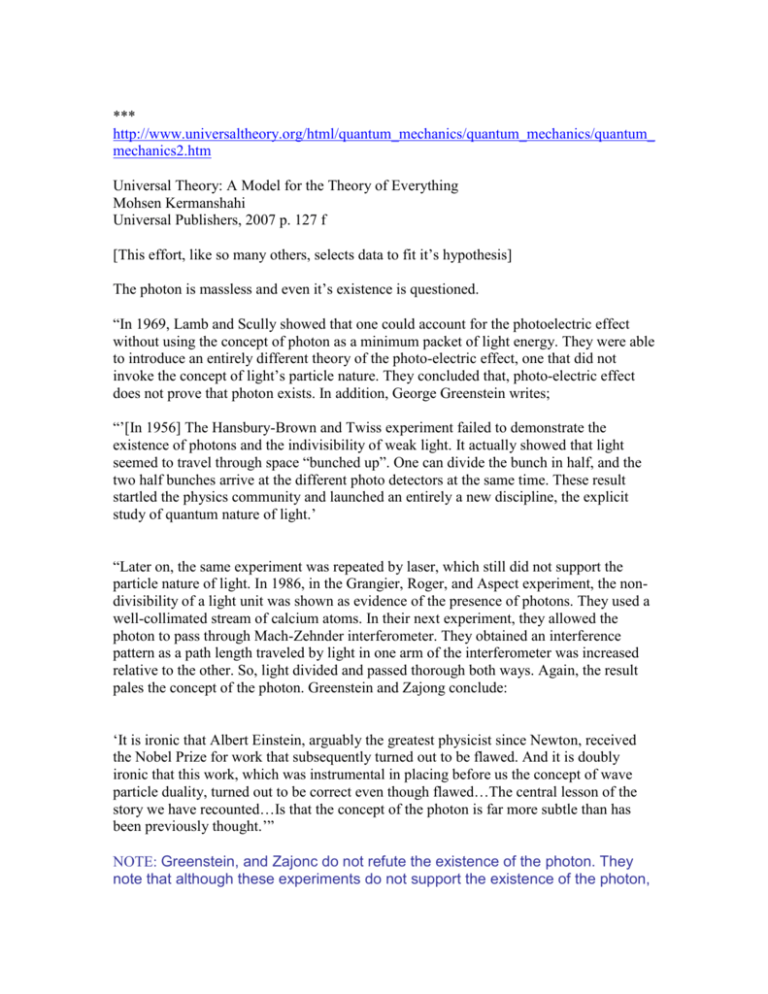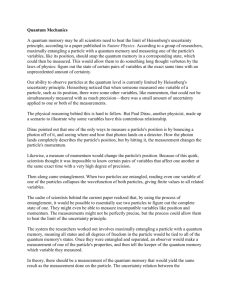Quantum Mechanics as dissolver of the sensate universe: this is
advertisement

*** http://www.universaltheory.org/html/quantum_mechanics/quantum_mechanics/quantum_ mechanics2.htm Universal Theory: A Model for the Theory of Everything Mohsen Kermanshahi Universal Publishers, 2007 p. 127 f [This effort, like so many others, selects data to fit it’s hypothesis] The photon is massless and even it’s existence is questioned. “In 1969, Lamb and Scully showed that one could account for the photoelectric effect without using the concept of photon as a minimum packet of light energy. They were able to introduce an entirely different theory of the photo-electric effect, one that did not invoke the concept of light’s particle nature. They concluded that, photo-electric effect does not prove that photon exists. In addition, George Greenstein writes; “’[In 1956] The Hansbury-Brown and Twiss experiment failed to demonstrate the existence of photons and the indivisibility of weak light. It actually showed that light seemed to travel through space “bunched up”. One can divide the bunch in half, and the two half bunches arrive at the different photo detectors at the same time. These result startled the physics community and launched an entirely a new discipline, the explicit study of quantum nature of light.’ “Later on, the same experiment was repeated by laser, which still did not support the particle nature of light. In 1986, in the Grangier, Roger, and Aspect experiment, the nondivisibility of a light unit was shown as evidence of the presence of photons. They used a well-collimated stream of calcium atoms. In their next experiment, they allowed the photon to pass through Mach-Zehnder interferometer. They obtained an interference pattern as a path length traveled by light in one arm of the interferometer was increased relative to the other. So, light divided and passed thorough both ways. Again, the result pales the concept of the photon. Greenstein and Zajong conclude: ‘It is ironic that Albert Einstein, arguably the greatest physicist since Newton, received the Nobel Prize for work that subsequently turned out to be flawed. And it is doubly ironic that this work, which was instrumental in placing before us the concept of wave particle duality, turned out to be correct even though flawed…The central lesson of the story we have recounted…Is that the concept of the photon is far more subtle than has been previously thought.’” NOTE: Greenstein, and Zajonc do not refute the existence of the photon. They note that although these experiments do not support the existence of the photon, they do not invalidate it. Experiments that show light is composed of photons will only succeed if the light sources used have the appropriate properties. Specifically, anticorrelations (indicating a particle presence) are only expected if the source produces light “in an eigenstate of the photon number operator.” P 34, The Quantum Challenge. “Wave particle duality also extends to the atom itself. Erwin Schrodinger goes even further to claim: ‘One can think of particles as more or less temporary entities within the wave field whose form and general behavior are nevertheless so clearly and sharply determined by the laws of waves that many processes take place as if these temporary entities were substantial permanent beings.’” [This phrase occurs at http://www.bibliotecapleyades.net/ciencia/time_travel/esp_ciencia_timetravel03.htm with no credits.] P 127 f. The quantum challenge: modern research on the foundations of quantum mechanics George Greenstein, Arthur Zajonc 2006 http://www.amazon.com/The-Quantum-Challenge-FoundationsMechanics/dp/076372470X Quantum mechanics part 1 Our mind activity frequently utilizes superposition in its different functions. QM part 2: Einstein believed Quantum Mechanics theory is deficient and cannot reveal the hidden variables that cause the bizarre findings in sub-atomic arena. He strongly believed that these variables do exist. According to Einstein a deeper theory would find these variables, which we are not aware of them at this time. Most physicists have not favored hidden variable theories. The well accepted Bell’s theorem contradict these theories. Note: But Bohm’s model does have these variables, and accommodates Bell’s theorem http://www.universaltheory.org/html/basics/boundaries_evidences/boundaries1.htm *** In the early 20th century, it was natural to speak of the elementary particles as being the “building blocks” of matter. At that time matter was believed to consist of atoms made up of a nucleus surrounded by a cloud of electrons. As the internal structure of the nucleus was probed, the number of “elementary particles” grew to a veritable zoo: 1 Werner Heisenberg, originator of Quantum Mechanics, argued that what was truly fundamental in nature was not the particles themselves, but the symmetries, or patterns that lay beyond them. These fundamental symmetries could be thought of as the archetypes of matter and the ground of material existence. The particles themselves would simply be the material realizations of those underlying abstract symmetries. These abstract symmetries, normally only ascertainable through mathematics, could be taken as the scientific descendents of Plato’s ideal forms. 2 The EPR thought experiment was devised by Einstein Podolsky and Rosen in an attempt to discredit the new quantum physics. This thought experiment said that if quantum theory were correct, a change in spin of one particle in a two particle system would effect its twin simultaneously, instantaneously, even if the two had been widely separated in space. A mathematical proof of this was produced by JS Bell in 1964, and experimentally confirmed in 1982. At the University of Paris a research team led by physicist Alain Aspect proved J.S. Bell’s Theorem: they discovered that under certain circumstances subatomic particles such as electrons are able to instantaneously communicate with each other regardless of the distance separating them. This property is phenomenon is called non-locality, and the particles are said to be “entangled”. Of course scientists disagree on the significance of Bell’s theorem and its confirmation, 3 but it seems to show that the material universe is "non-local." This effect is not necessarily the result of a transfer of information, but could be a consequence of the one-ness of apparently separate objects. The rigorous mathematics of Quantum Mechanics was thus seen to wreak havoc with a sensate interpretation of the material world. 1 F. David Peat Synchronicity: The Bridge Between Matter and Mind . p. 94 2 F. David Peat Synchronicity: The Bridge Between Matter and Mind p. 94 f. 3 Diverse perspectives on the significance of non-locality: http://www.physlink.com/Education/askexperts/ae634.cfm







